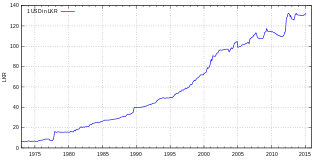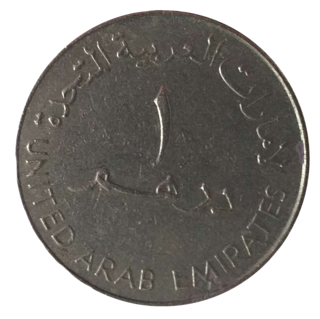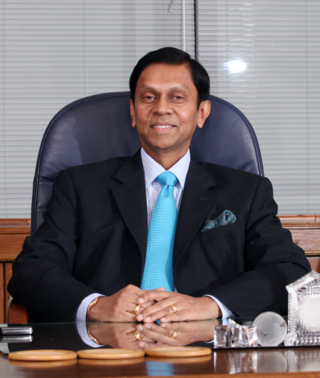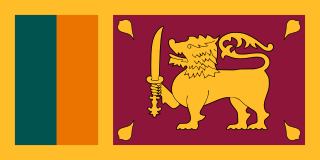The Central Bank of Sri Lanka has issued commemorative coins since 1957.
Contents
On 15 December 2010, to mark the 60th Anniversary, the Central Bank of Sri Lanka issued a Frosted Proof crown size multi-colour silver commemorative coin in the denomination of Rupees 5000. It was the first multi-colour coin issued by the Central Bank.
Commemorative coins issued by the Central Bank of Sri Lanka:
| Commemorative Coins of Sri Lanka | ||||||||
|---|---|---|---|---|---|---|---|---|
| Image | Value (Rs.) | Description | Obverse | Reverse | Diameter/Size (mm) | Metal | Weight (Grams) | Year |
| 5 | 2500th Anniversary of the passing away of Buddha (Buddha Jayanthi) | 38.61 | Silver (0.925) | 28.28 | 1957 | |||
| 1 | 2500th Anniversary of the passing away of Buddha (Buddha Jayanthi) | 28.50 | Copper Nickel | 11.31 | 1957 | |||
| 2 | 2nd World Food Congress | 31.50 | Copper Nickel | 12.35 | 1968 | |||
| 5 | 5th Non-Aligned Summit Conference | 32.84 | Nickel | 13.60 | 1976 | |||
| 2 | 5th Non-Aligned Summit Conference | 30.00 | Copper Nickel | 13.50 | 1976 | |||
| 1 | 1st Executive Presidency (J. R. Jayawardhane) | 24.50 | Copper Nickel | 7.13 | 1978 | |||
| 1 | 1st Executive Presidency (J. R. Jayawardhane) | 24.50 | Gold 22 Caret | 12.00 | 1978 | |||
| 5 | 50 Years of Universal Adult Franchise | 29.0 / 30.28 | Copper Nickel | 9.60 | 1981 | |||
| 2 | The Mahaweli Development Scheme | 28.50 | Copper Nickel | 8.25 | 1981 | |||
| 5 | International Year of Shelter for the Homeless | 25.0 – 30.0 | Copper Nickel | 11.70 | 1987 | |||
| 500 | 40th Anniversary of Central Bank of Sri Lanka | 38.61 | Silver | 28.28 | 1990 | |||
| 100 | 5th South Asian Federation Games – Colombo | 22.0 – 29.4 | Silver | 10.20 | 1991 | |||
| 500 | 5th South Asian Federation Games – Colombo | 14 | Gold 12 Caret | 1.6 | 1991 | |||
| 1 | 3rd Anniversary of Induction of Executive Presidency – R. Premadasa | 25.40 | Copper Nickel | 7.13 | 1992 | |||
| 500 | 2300 Anubudu Mihindu Jayanthi | 38.61 | Silver | 28.28 | 1993 | |||
| 5 | 50th Anniversary, United Nations | 23.50 | Ni / Br | 9.50 | 1995 | |||
| 5000 | 50th Anniversary of Sri Lanka regaining Independence | 22.05 | Gold (22 Caret) | 7.98 | 1998 | |||
| 1000 | 50th Anniversary of Sri Lanka regaining Independence | 38.61 | Silver | 28.28 | 1998 | |||
| 10 | 50th Anniversary of Sri Lanka regaining Independence | Outer ring 27.0 Inner disc 18.0 | Bi Metal Outer ring Cu/Ni Inner disc Ni/Br | 9.00 | 1998 | |||
| 1000 | Winning of the 1996 Cricket World Cup | 38.61 | Silver | 28.28 | 1999 | |||
| | 5 | Winning of the 1996 Cricket World Cup | 23.50 | Ni / Br | 9.50 | 1999 | ||
| 1 | 50th Anniversary of Sri Lanka Army | 25.40 | Nickel-plated steel | 7.13 | 1999 | |||
| 1000 | 50th Anniversary Central Bank of Sri Lanka | 38.61 | Silver | 28.28 | 2000 | |||
| 1000 | 50th Anniversary of Sri Lanka regaining Independence | 38.61 | Silver | 28.28 | 1998 | |||
| 1 | 50th Anniversary of Sri Lanka Navy | 25.40 | Cu-Ni | 7.13 | 2000 | |||
| 1 | 50th Anniversary of Sri Lanka Air Force | 25.40 | Cu / Ni | 7.13 | 2000 | |||
| 2 | 50th Anniversary of the Colombo Plan | 28.50 | Cu / Ni | 8.25 | 2000 | |||
| 5 | 250th Anniversary of Syamopasampadawa (Weliwita Sri Saranankara Sangaraja Mahimi) | 23.50 | Ni / Br | 9.50 | 2003 | |||
| 1500 | 2550th Anniversary of the passing away of Buddha | 38.61 | Silver (0.925) | 28.28 | 2006 | |||
| 2000 | 2550th Anniversary of the passing away of Buddha | 38.61 | Silver (selective gold-plated) | 28.28 | 2006 | |||
| 5 | 2550th Anniversary of the passing away of Buddha | 23.50 | Brass-plated steel | 9.50 | 2006 | |||
| 1000 | Cricket World Cup 2007 (Runner up) | 32 | Nickel-plated steel | 12 | 2007 | |||
| 5 | Cricket World Cup 2007 (Runner up) | 28.50 | Brass-plated steel | 7.00 | 2007 | |||
| 1000 | 50th Anniversary of Employee's Provident Fund Commemorative Coin | 28.50 | Nickel-plated steel (brilliant uncirculated) | 7.00 | 2008 | |||
| 2 | 50th Anniversary of Employee's Provident Fund Commemorative Coin | 28.50 | Nickel-plated steel | 7.00 | 2008 | |||
| 200 | Sri Lanka Customs Commemorative coin | Silver | 10.50 | 2008 | ||||
| 1000 | 60th Anniversary of the Sri Lanka Army | 28.50 | Silver | 11.90 | 2009 | |||
| 1000 | 60th Anniversary of the Sri Lanka Army | 28.50 | Cu-Ni | 8.25 | 2009 | |||
| 5000 | 60th Anniversary Central Bank of Sri Lanka [1] | Central Bank Crest | A tree depicting the growth and the stability of Sri Lanka's economy | 38.61 | Silver | 28.28 | 2010 | |
| 2 | 60th Anniversary of the Sri Lanka Air Force [2] | Logo of Sri Lanka Air Force in the centre. An artist's impression of a Chipmunk aircraft appears below the logo and another three aircraft; Mig 27, C 130, and MI 24 appear above the logo. | Two (face value) in large numerals and the words "Two Rupees" in Sinhala, Tamil and English appear across the face value. | 28.5 | Nickel-plated steel | 7 | 2 March 2011 | |
| 2000 | 125th anniversary of Ananda College | At centre an image of Ananda Viharaya with rays above depicting impact of knowledge and education. Below from left to right portraits of Hikkaduwa Sri Sumangala Thera (1827-1911), Migettuwatte Gunananda Thera (1823-1890), and Colonel Henry Steele Olcott (1832-1907) as founders of Ananda with anniversary dates 1886-2011 inside a semi-circle. | At centre above the Ananda College crest, the face value 2000 in numerals below RUPEES in Sinhala, English and Tamil. The crest in the shape of a shield has the standing Sinhala Lion below the Buddhist Stupa with radiant pinnacle. On top the motto in Pali, Appamdho Amathapadhan – Buddhist quote from the Apramadha Vagga in the Dhammapada meaning: "Heedfulness leads to Nirvana". | 38.61 | Silver | 28.28 | 2011 | |
  | 20 | 70th anniversary of the Central Bank of Sri Lanka. [3] The coin is a heptagon and consists of 7 sides (7 lobed coin). | The image of the headquarters of Central Bank of Sri Lanka with 70 which depicts the anniversary. It also includes the years of operation of the Central Bank of Sri Lanka (1950 – 2020). The text "Central Bank of Sri Lanka" is written in all three main languages Sinhala, Tamil & English. | 20 (which is the face value) of the coin is shown in the reverse with the text "Twenty Rupees" written in all three main languages Sinhala, Tamil & English. The text "Sri Lanka" is also written in Sinhala, Tamil & English. | 28mm diameter and 2mm thickness | Aluminium Bronze | - | 2020 |









